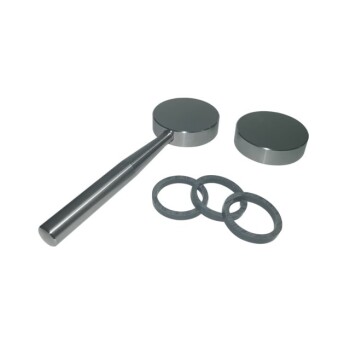XRF spectrometers, also known as X-ray fluorescence analyzers, are advanced instruments used to analyze the elemental composition of materials.
These instruments work by exciting atoms in a sample with X-rays.
This excitation causes the atoms to emit secondary X-rays.
These secondary X-rays are then detected and analyzed to determine the presence and concentration of various elements.
XRF technology is widely used in various industries for quality control, research, and environmental monitoring.
5 Key Points Explained

1. Basic Operation of XRF Spectrometers
XRF spectrometers consist of an X-ray source and a detector.
The X-ray source generates X-rays that are directed at the sample.
The detector captures the secondary X-rays emitted by the sample.
Sometimes, a filter is used to modify the X-ray beam to enhance the quality of the analysis.
The detector processes the received X-rays to generate a spectrum.
This spectrum shows the presence of various elements in the sample based on the intensity of different peaks.
2. Range of Analyzable Elements
XRF spectrometers can analyze elements ranging from sodium (Na) to uranium (U).
Each element has different detection levels depending on the availability of orbitals to which excited electrons can move.
3. Types of XRF Spectrometers
Energy Dispersive XRF (ED-XRF) spectrometers are simpler and can simultaneously collect signals from several elements.
They offer resolution from 150 eV to 600 eV.
Wavelength Dispersive XRF (WD-XRF) spectrometers collect signals one at a time at different angles using a goniometer.
They are more complex and expensive but offer higher resolution, from 5 eV to 20 eV.
4. Applications of XRF Spectrometers
XRF spectrometers are used in various industries, including cement, metal ores, mineral ores, oil & gas, environmental, and geological applications.
They are also essential tools for analyzing automotive catalysts due to their accuracy and speed.
5. Qualitative and Quantitative Analysis
Qualitative analysis involves identifying elements present in the sample based on the unique spectrum produced by each element.
Quantitative analysis uses the intensity of the fluorescent X-rays to determine the concentration of elements in the sample.
This involves corrections for absorption and other factors to ensure accurate results.
6. Calibration and Versatility
XRF spectrometers can include multiple calibrations for different tasks.
This makes them versatile tools for analyzing the elemental composition of various materials, such as autocatalysts, alloys, and ores.
7. Detection Limits and Capabilities
XRF spectrometers can detect elements in the range of 1–10 mg kg−1.
This makes them suitable for a wide range of applications where precise elemental analysis is required.
In summary, XRF spectrometers are essential tools for elemental analysis.
They offer a wide range of applications in various industries.
Their ability to provide both qualitative and quantitative analysis with high accuracy and speed makes them invaluable for quality control, research, and environmental monitoring.
Continue Exploring, Consult Our Experts
Discover how our advanced XRF spectrometers, with their ability to identify and measure elements from sodium to uranium, can revolutionize your analysis.
From ED-XRF for versatility to WD-XRF for superior resolution, KINTEK SOLUTION offers tailored solutions for your industry needs.
Unlock the potential of precise elemental analysis for quality control, research, and environmental monitoring.
Don't miss out – Contact KINTEK SOLUTION now to experience the power of XRF technology in your lab!












